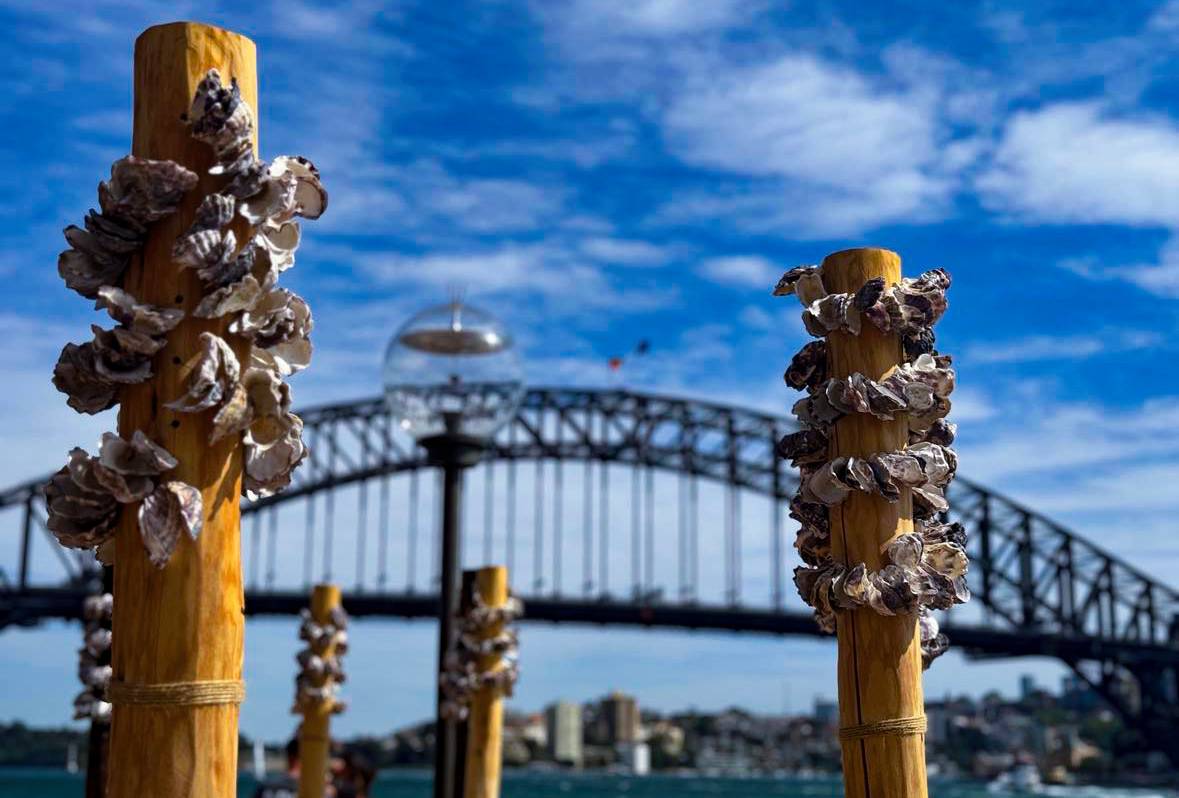OzFish digs deep to help Sydney Opera House celebrate 50 years with a shellfish exhibition

OzFish Unlimited’s shellfish recycling has branched out into a new area with highly acclaimed First Nations artist Megan Cope using oyster shells within her public art.
More than 85,000 oyster shells have been positioned across the Sydney Opera House precinct by the Quandamooka artist to evoke the ancestral midden sites that were used at this location for Aboriginal celebrations and gatherings for thousands of years.
The “Whispers” exhibition, which is now open and runs until the end of October as part of the Opera House’s 50-year anniversary celebrations, features 200 timber Kinyingarra Guwinyanba poles – the phrase means “a place of oysters” in the Jandai language of the Quandamooka people – at the iconic landmark’s northern boardwalk.
Ms Cope says the poles, covered with oysters, stand as symbols of ecological rebirth and ancestral homage, echoing the call of collective memory and Indigenous resilience.
They connect to a 14-metre wall of shells that frame the western side of the building and emerge through the upper podium.
OzFish is proud to play a part in the project, donating tens of thousands of used shells, and recognises the immense value of working closely with and learning from Australia’s Indigenous traditions.
“Collaborating with artists like Megan Cope not only highlights the artistic and creative talents of First Nations individuals but also allows for a deeper understanding of the cultural and ecological significance of shellfish reefs within Indigenous communities,” said Robbie Porter, OzFish’s Senior Special Projects Officer – Shellfish Revolution.
“OzFish’s involvement in the exhibition offers a chance to establish a strong connection between art, culture, and conservation.
“By celebrating the voices and perspectives of First Nations people, OzFish aims to amplify Indigenous knowledge and values in marine habitat restoration efforts.
“We recycle tonnes of shells every year to be used to restore lost shellfish reefs and it was great to support this exhibition and share our message to more people.”
Ms Cope said oystering was a critical part of the culture for people from Quandamooka Country, the waters and lands around Moreton Bay and the islands Mulgumpin (known also as Moreton Island), Minjerribah (now also known as North Stradbroke Island), the Southern Moreton Bay islands and South Stradbroke Island.
“It’s devastating to come to terms with how colonial relationships have to material and to Country,” she said.
“The work is about remembering what was there and paying respect to our ancestors.
“When we look at oysters, it’s such a fascinating material and there’s like material politics attached to it, there’s also social politics attached to it.
“I want it to be inclusive, I want it to embody the things that our people based our fundamental social, philosophical framework on.
“When it comes to the work that needs to happen in this country, reconciling with history, including Aboriginal people in our way forward, it’s really important for people to be engaging with, looking at this oyster, like marvelling over it, going ‘wow, I’ve never spent this much time with an oyster, look at how beautiful it is’.
“I hope this just blows everyone away and reminds them to love and respect Country, to understand Deep Time and actually become more connected with our ways of understanding kinship, Country, connection.”
OzFish has been the driving force behind the largest community-driven shellfish reef restoration project in Australia in Moreton Bay.
Volunteers are working towards an ambitious goal of building more than 50,000 Robust Oyster Baskets (ROBs) and deploying them to reform a living vibrant ecosystem donated for restoration by the Port of Brisbane.
Over the past year, Ms Cope has enlisted more than 3000 volunteers to participate in dozens of workshops at the Opera House forecourt, Addison Road Community Centre in Marrickville and the artist’s studio in Brisbane.
They have cleaned, polished, drilled and threaded thousands of shells by hand, with their shared narratives and kinships elevating the humble oyster shell into a symbol of a community, heritage and Country.





